The Next Best Thing to Being There—STEAM Studio Youngsters Explore the Amazon with the Help of CITL
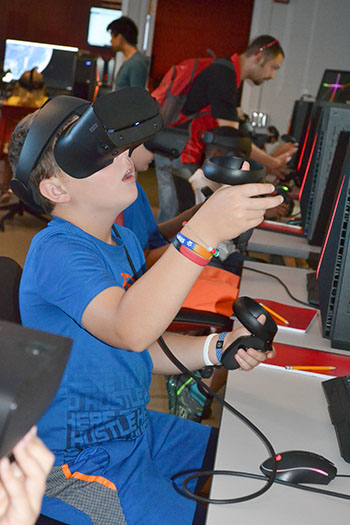
October 3, 2019
Here’s the scenario. On their way home from a gecko conference, their plane crashed in the Amazon, where they had to survive in the unfamiliar, somewhat hostile environment and to figure out how to return home using GPS technology. This scenario was part of a 6–8 week unit about the Amazon Rain Forest that third graders in Next Generation School’s STEAM Studio after-school program did this fall. Activities included studying geckos and building tents for shelter. Plus, to enhance their experience, they visited CITL’s (Center for Innovation in Teaching & Learning) Armory Innovation Spaces: Innovation Studio and TechHub. There, armed with VR goggles, they zoomed in on the Amazon using Google Earth, watched YouTube 360 videos to experience the rain forest, and even laser printed luggage tags. Immersed in such fun, creative, and high-tech activities to study the Amazon, what student couldn’t help but learn?
One of the first activities in the unit, was not just learning about geckos, but seeing some up close (the gecko conference part of the unit’s scenario). STEAM Studio Director Angela Nelson, explains about the geckos. "They had a ‘gecko conference’ before this,” she explains, “so they've already learned about geckos. And actually, this class has a new gecko pet. They had to create a little carrier for their pet, learn how to take care of it, and everything like that.”
A key part of the unit was a field trip to CITL’s Innovation Spaces in the Armory. For instance, at the Innovation Studio, eLearning professional Jim Wentworth and his team led the students in exploring how GPS works (the figure-out-how-to-get-out-of-the-jungle part of the scenario).
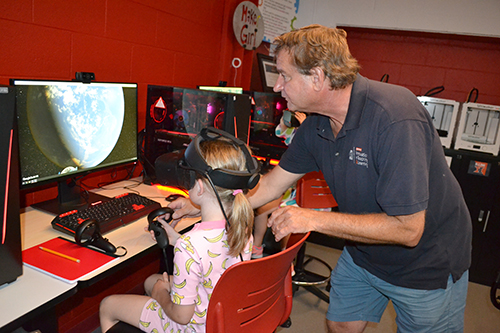
Jim Wentworth helps a student who's using Google Earth 360 to explore the Amazon.
“So right now they just crashed,” Nelson explains regarding the CITL visit, “And the reason they crashed was they were coming back from the gecko conference. Now they have four more weeks to get to a town and hopefully get out.”
How do they do that? They use GPS, of course. “They're going to learn about coordinates and mapping and all of those pieces, because they have to figure out how to get to the next city to make themselves safe,” she explains.
Regarding the part of the scenario where his students crash land in the Amazon, Scott Blanck, who teaches third grade at Steam Studio, agrees: “They have to be able to learn how to survive and what different things they're going to have to do to be able to find a way to get back to civilization."
So after donning Virtual Reality headsets, the students used Google Earth to zoom in on the Amazon Rain Forest. The idea was that they were to not only explore part of the Amazon, but look at a specific civilization that would be incorporated into one of the activities they’d be doing during the next step of the unit.
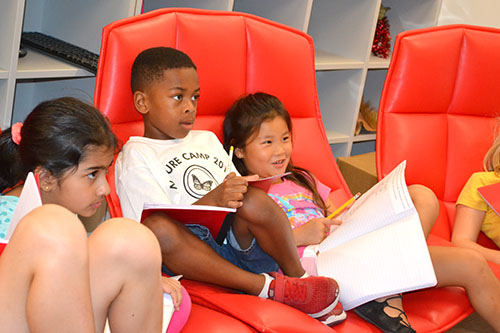
Students watch a YouTube360 video of the Amazon rain forest.
(As an aside, this reporter saw one kid exploring a picturesque village in France, and another stuck in Indiana, trying to get to Illinois. But while the kids weren’t necessarily exploring the Amazon River basin the entire time, they were definitely figuring out how to use Google Earth and GPS.)
Halfway through their Armory visit, the two groups of students switched places, so the group that had been in the Innovation Studio visited the TechHub, and vice versa. At TechHub, they got to look at four different YouTube 360 videos about the Amazon, which allowed the kids to see what the rain forest was like up close.
“They're recording all of their experiences along the way so that they're going to be able to share with others what they discovered along the way,” Nelson explains about having students keep records of all that they experienced. Students, who weren’t just supposed to watch the YouTube 360 videos, but to journal their experience. Nelson shares some explicit instructions she gave them.
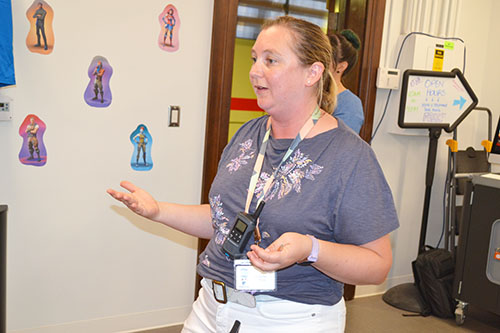
STEAM Studio Director Angela Nelson explains the procedure for the YouTube360 activity.
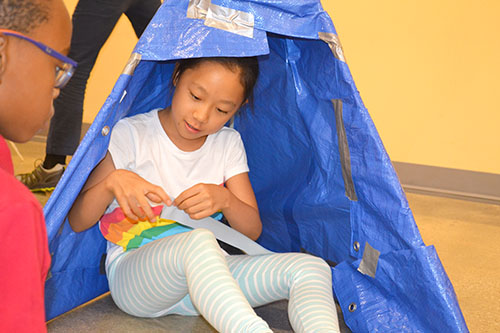
A student works on the inside of her team’s tent.
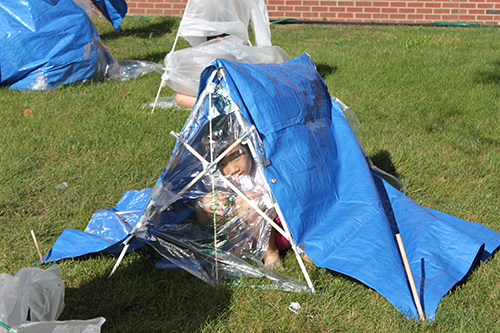
A student is hunkered down in her team’s tent, awaiting the monsoon test—being sprayed with a hose! (Image courtesy of Angela Nelson.)
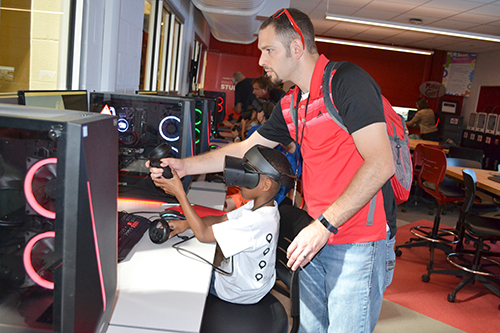 STEAM Studio 3rd grade teacher Scott Blanck works with one of his students.
STEAM Studio 3rd grade teacher Scott Blanck works with one of his students.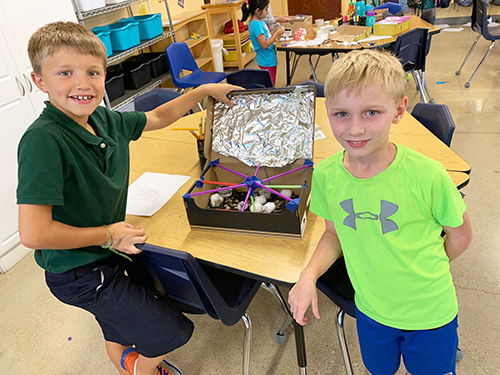
Students show off the carrier they made for their gecko. (Image courtesy of Angela Nelson)
“You are going to see what it looks like to be in the rain forest,” she explains to her students. “You will need your notebooks; you need to take notes; you need sketches; you need details, because you will be doing a journal entry to tell everyone what it was like when you got off the plane and what it looked like.”
Plus, as the students watched these videos, the TechHub lab assistant moved the 360° camera around, so they could see the different areas.
The students also got to make luggage tags using a laser printer at the TechHub, purportedly so they would be able to find their luggage and pull it out of the wreckage. For this activity, first the students chose from a selection of animals from the Amazon, then, they got to see the process, watching as a laser printer made their luggage tags, embossing the animals they’d selected on them.
Another activity later on in the unit involved a more engineering-related activity. To “survive” in the Amazon, the students were to design, build, then test rain-forest-monsoon-proof tents, ostensibly built from the plane’s wreckage.
“And then we're going to look at weather as well,” Angela Nelson explains. “And if it was raining, how are you going to stay dry in the middle of the night? They're actually going to create their own tents using supplies that they have taken from the plane.” She says students will have to look at everything that’s on the plane, and decide what they want to take. Of course, they can only carry so much, so they have to weigh it. The problem is, when choosing, they don't even know how they're going to use it yet. “It's just a matter of taking the stuff,” she continues, and then they're going to create these shelters, and we're actually going to take hoses with water and spray them and see how dry they stay underneath them,” Nelson admits.
Building a waterproof tent is just the beginning, regarding some of the engineering-type activities students did. “It's going to be a huge mix of activities coming up,” Nelson explains about some of the other predicaments the students would encounter:
“They have to get through the river; they're going to have to create their own rafts. They also have to get across a valley, so they have to create a bridge. They're going to learn about tree houses and build those, figure out what food they're going to eat now that is edible. They visited the UIUC greenhouse to learn what to stay away from and what they can actually touch and use in the rainforest.”
Blanck shares why it’s good to expose kids to stuff like this. “It's more of an authentic experience for kids so that they can get that true authentic learning versus that rote practicing that is so often in education.”
In other words, rather than reading a geography book, or hearing their teacher present a lecture on the rain forest, the students were immersed in it—virtually. Bennet shares the benefit of this kind of learning.
“These kids are getting to work with the experts in their field. For this, we can't get to the rainforest with these kids, but they can actually see the rain forest and through virtual reality, be in the rainforest and see what that would feel like and discover how big things are. I can see the trees are huge, but unless you're standing and you look up and you see how big it is, it doesn't mean that much.”
Regarding making the luggage tags, she says they were “Something simple that you wouldn't even think about related to the rain forest.” But they figured out how to include them in the unit so the kids could use a tool like a laser cutter. For the STEAM Studio staff who dreamed up the unit, the goal was exposing their kids to this cutting-edge technology: “Getting them these opportunities to see how these tools can be applied for different activities and projects that we're doing.”
Regarding the impact on the kids, Nelson says they really enjoyed it: “They are doing really well. You should see their notes, the sketches and the details that they have. They are ready to do that first journal entry for sure.”
Her charges, who’ve also done 3D printing, especially enjoyed the laser printing.
“Actually, the laser printing was a surprise for them. You should have seen the first kids when they came in; their eyes were just so bright and they were excited to get that opportunity. Yesterday we had a group come in and they were talking, comparing it to 3D printing. It's kind of nice since they're starting to have enough experiences with different tools that they're discussing, ‘Oh, well the 3D printer takes so long to build this, whereas I can do this in 3 minutes and have a product!’ It's good that they're starting to see those comparisons.”
Story by Elizabeth Innes, Communications Specialist, I-STEM Education Initiative. Photos by Elizabeth Innes unless otherwise noted.
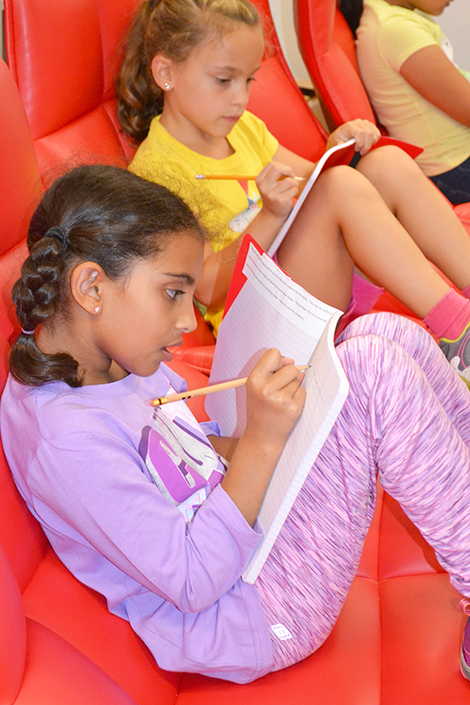
STEAM studio 3rd graders take careful notes of what the Amazon rain forest is like.
More: CITL, K-6 Outreach, Next Generation School, STEAM/SciArt, STEAM Studio, 2019
For more I-STEM articles about STEAM Studio and Next Generation School, please see the following:
- STEAM Studio AstroTech Unit Focuses on Telescopes Courtesy of Astronomy’s Wong
- Van der Veen Team Teaches STEAM Studio Students Why Air Pressure Variations and Vacuums Warrant Wacky Weather
- NGS’ Science Social Café Exposes Girls to Women in Science—Broadens Narrow Notions About Careers in Science
- At NGS’ Science Social Café, MCBees Women Serve as Role Models, Exemplify Careers in Science
- Wai-Tat Fu's Lab Partners with STEAM Studio To Make STEM, Spatial Reasoning Fun
- STEAM Studio's STEAMcation Students Visit RailTEC...Learn All About Trains
- Illinois' MCBees Expose STEAM Studio's STEAMcation Students to Medieval Science
- Next Gen's STEAM Studio: An After-School STEM Program With a Dab of Creativity
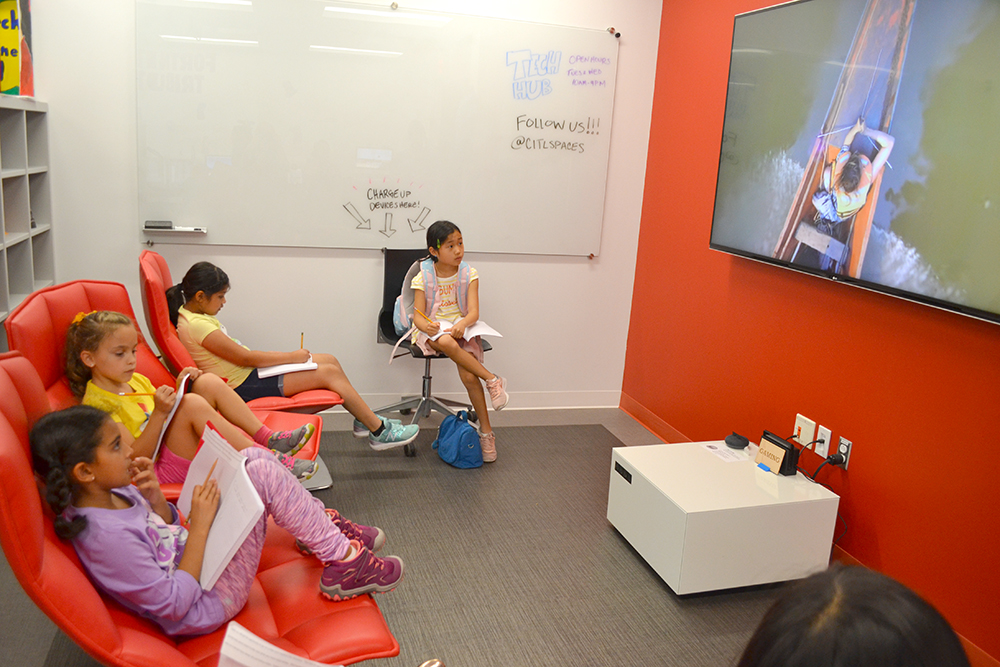
Students watch as a boat glides down the Amazon river in one of the YouTube360 videos.
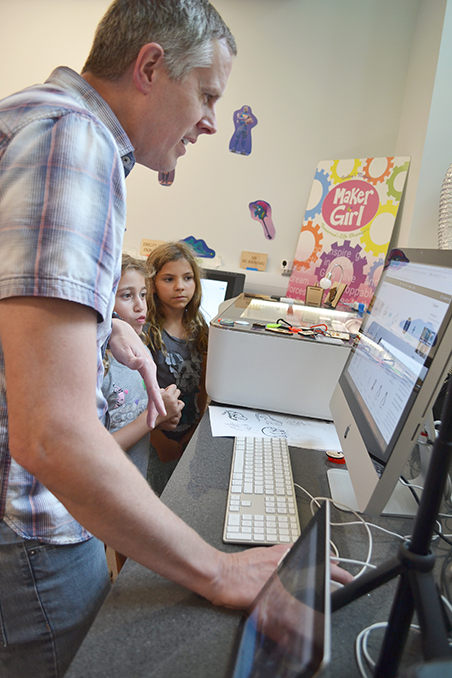
STEAM studio students watch as CITL Tech Hub’s Jamie Nelson (left) sets the Laser Printer to begin printing their luggage tags.

STEAM Studio students design a water filtration system for water that they found on their travels. (Image courtesy of Angela Nelson.)
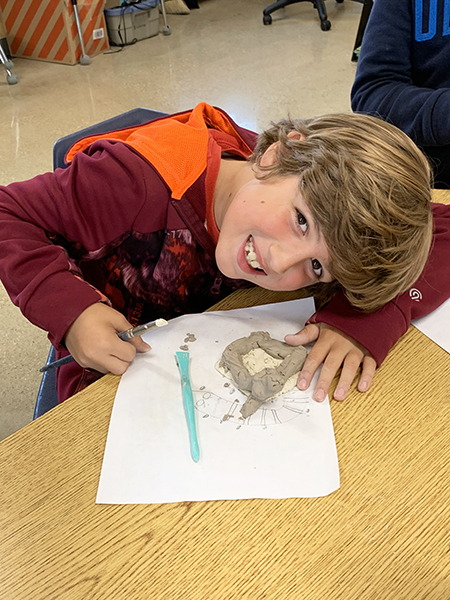
A STEAM Studio student enjoys creating a clay model of a gecko. (Image courtesy of Angela Nelson.)













.jpg)
















